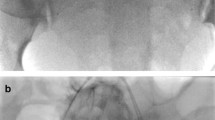Abstract
Background
Placenta previa is one condition, where the bleeding is from the thinned out lower segment, which faces difficulty in contracting as compared to the upper uterine segment. To combat postpartum hemorrhage and hysterectomy, there were various techniques adopted in obstetric practice. Here the aim is to study the bilateral internal iliac artery ligation (BIL) as a technique to minimize postpartum bleeding and preserve the uterus for future pregnancy.
Methods
This retrospective study was conducted in 31 patients with abnormal placentation. They underwent BIL during LSCS. The surgery was elective in non-bleeding patients and as an emergency in bleeding patients. The primary outcome is to minimize blood loss and postpartum blood transfusion. The secondary outcome is the prevention of hysterectomies after delivery and preservation of the uterus for the mother to have future pregnancies.
Results
Out of 31 women, 19 underwent elective surgery (61.3%) and 12 underwent emergency surgery (38.7%). Out of 12 emergency surgeries, 8 needed blood transfusion due to blood loss. Out of 19 elective surgeries, none required the blood transfusion. Blood transfusion was required in 50% of the patient in emergency BIL surgery, whereas none required blood transfusion in elective BIL surgery. Postpartum hysterectomy was avoided in all study participants except one elective surgery patient.
Conclusion
BIL surgery can be an effective procedure for handling high-risk obstetric hemorrhage in addition to the chances of future fertility through the preservation of uteri.
Similar content being viewed by others
References
Lin CC, Adamczyk CJ, Montag AG, et al. Placenta previa percreta involving the left broad ligament and cervix: a case report. J Reprod Med. 1998;43:839–43.
Say L, Chou D, Gemmill A, et al. Global causes of maternal death: a WHO systematic analysis. Lancet Glob Health. 2014;2(6):e323–33.
Gaspare C, D’Alfonso A, Armando N, et al. Conservative surgical management of placenta previa and accreta. A case report. SOJ Surg. 2014;1(1):3.
Huang K-L, Tsai C-C, Fu H-C, et al. Prophylactic transcatheter arterial embolization helps intraoperative hemorrhagic control for REMOVING invasive placenta. J Clin Med. 2018;7(11):460.
Desai R, Jodha B, Garg R. Morbidly adherent placenta and it’s maternal and fetal outcome. Int J Reprod Contracept Obstet Gynecol. 2017;6(5):1890–3.
Usta IM, Hobeika EM, Musa AA, et al. Placenta previa-accreta: risk factors and complications. Am J Obstet Gynecol. 2005;193:1045–9.
Cresswell JA, Ronsmans C, Calvert C, et al. Prevalence of placenta praevia by world region: a systematic review and meta-analysis. Trop Med Int Health. 2013;18(6):712–24.
FaSziller I, Hupuczi P, Papp Z. Hypogastric artery ligation for severe hemorrhage in obstetric patients. J Perinat Med. 2007;35:187–92.
Arias F, Bhide A, Arulkumaran S, et al. Antepartum haemorrhage: practical guide to high risk pregnancy and delivery. London: Elsevier; 2015. p. 152–3.
Faiz AS, Ananth CV. Etiology and risk factors for placenta previa: an overview and meta-analysis of observational studies. J Matern Fetal Neonatal Med. 2003;13(3):175–90.
Hendricks MS, Chow YH, Bhagavath B, et al. Previous cesarean section and abortion as risk factors for developing placenta previa. J Obstet Gynecol Res. 1999;25(2):137–42.
Gurol-Urganci I, Cromwell DA, Edozien LC, et al. Risk of placenta previa in second birth after first birth cesarean section: a population-based study and meta-analysis. BMC Pregnancy Child Birth. 2011;21(11):95.
Rosenberg T, Pariente G, Sergienko R, et al. Critical analysis of risk factors and outcome of placenta previa. Arch Gynecol Obstet. 2011;284(1):47–51.
Nankali A, Keshavarzi F, Shajari A, et al. Frequency of placenta previa and maternal morbidity associated with previous cesarean delivery. Open J Obstet Gynecol. 2014;4:903–8.
Grobman WA, Gersnoviez R, Landon MB, et al. Pregnancy outcomes for women with placenta previa in relation to the number of prior cesarean deliveries. Obstet Gynecol. 2007;110:1249–55.
Kollmann M, Gaulhofer J, Lang U, et al. Placenta praevia: incidence, risk factors and outcome. J Matern Fetal Neonatal Med. 2016;29:1395–8.
Maiti S, Kanrar P, Karmakar C, et al. Risk factors of placenta previa among rural Indian women. J Evol Med Dent Sci. 2014;3(65):14163–8.
Chantraine F, Braun T, Gonser M, et al. Prenatal diagnosis of abnormally invasive placenta reduces maternal peripartum hemorrhage and morbidity. Acta Obstet Gynecol Scand. 2013;92:439–44.
Jauniaux E, Collins S, Burton GJ. Placenta accreta spectrum: pathophysiology and evidence-based anatomy for prenatal ultrasound imaging. Am J Obstet Gynecol. 2018;218:75–87.
Shah M, Wright JD. Surgical intervention in the management of postpartum hemorrhage. Semin Perinatol. 2009;22(2):109–15.
Onwere C, Gurol-Urganci I, Cromwell DA, et al. Maternal morbidity associated with placenta praevia among women who had elective caesarean section. Eur J Obstet Gynecol Reprod Biol. 2011;159(1):62–6.
Author information
Authors and Affiliations
Corresponding author
Ethics declarations
Conflict of interest
The author declares no conflict of interest.
Ethical Standard
The study was approved by the Institutional Ethics Committee.
Additional information
Publisher's Note
Springer Nature remains neutral with regard to jurisdictional claims in published maps and institutional affiliations.
Dr. M. Madhubala is a Senior Consultant, Department of Obstetrics and Gynecology and Fertility Care Centre, Lakshmi Madhavan Hospital.
Rights and permissions
About this article
Cite this article
Madhubala, M. Bilateral Internal Iliac Artery Ligation, a Rational Choice of Surgery in Placenta Previa, a Hospital-Based Retrospective Study on the Prevention of Hysterectomy and Control of Postpartum Hemorrhage. J Obstet Gynecol India 69, 535–540 (2019). https://doi.org/10.1007/s13224-019-01258-8
Received:
Accepted:
Published:
Issue Date:
DOI: https://doi.org/10.1007/s13224-019-01258-8




